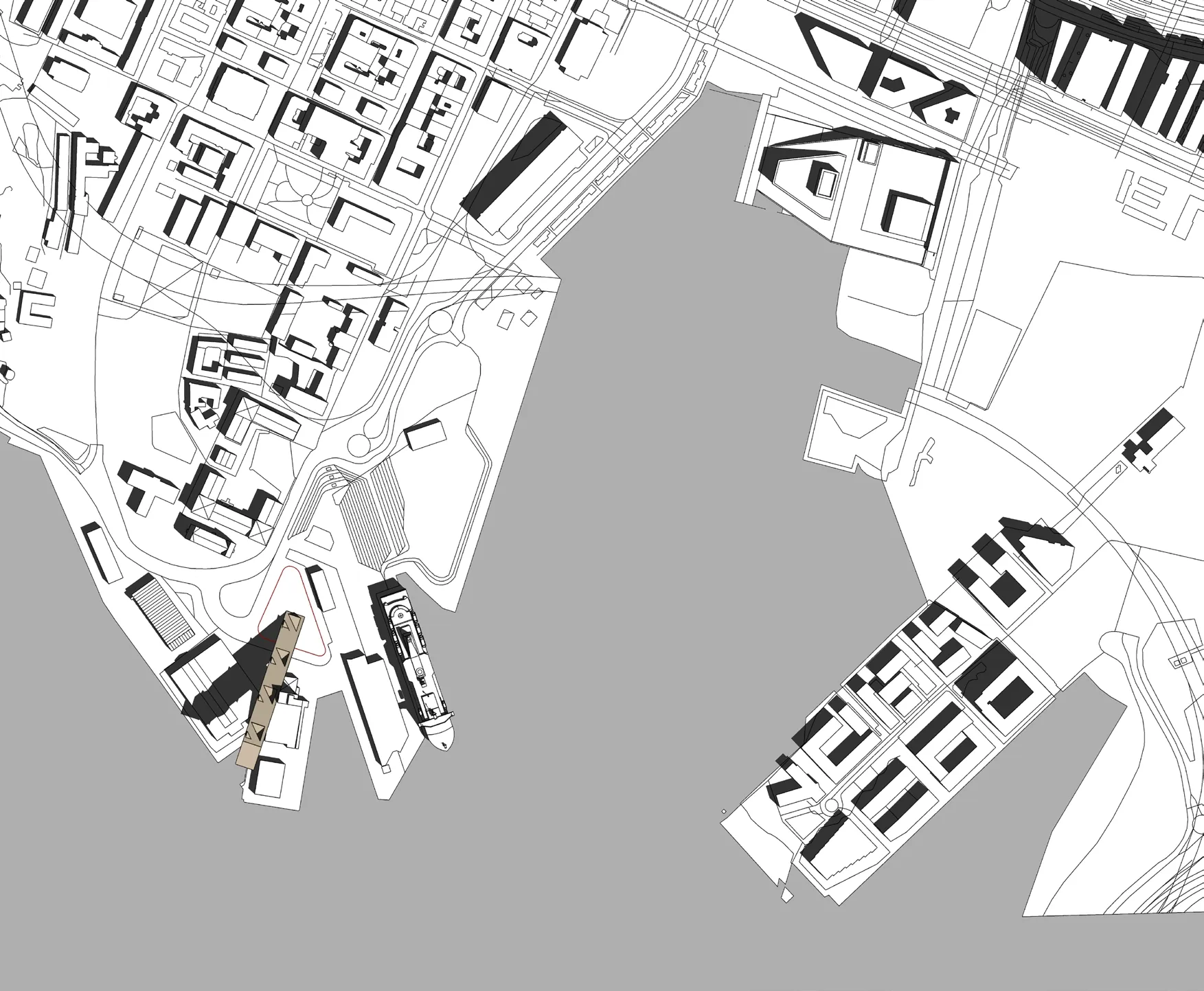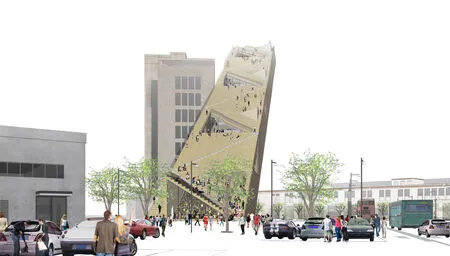奥斯陆天梯
——挪威滨水文化中心设计竞赛,挪威奥斯陆
2019-10-30朱文一
朱文一
简况
地点:挪威奥斯陆
时间:2019年2月至4月
主办:https://startfortalents.net
项目:挪威滨水文化中心设计竞赛
团队:
主创建筑师:朱文一
成员:岳阳,卞一之
Facts
Location: Oslo, Norway
Time: February—April 2019
Host: https://startfortalents.net
Program: OsloCall - Cultural Center for Norvegian Waterfront
Design Team
Chief Architect: ZHU Wenyi
Team Member: YUE Yang, BIAN Yizhi
奥斯陆是北欧国家挪威的首都,其著名的滨水港湾也是各式先锋建筑涌现之地。竞赛地段选在活跃的港口滨水地带,南接码头,北邻防务博物馆等老城区建筑。从奥斯陆老城区来看,地段处在奥斯陆城中心水陆区域地理中心,区位非常优越。竞赛要求参赛者完成规模为15,000m2的挪威滨水文化中心设计。朱文一工作室提交的“天梯”方案(图1)在呼应老城空间、注重滨水可达、创造独特空间等方面进行了探索。
第一,极佳的地理位置具有潜在的城市地标可能性。“天梯”状设计方案高84m,充分考虑了从西北方向市政厅、从北面的歌剧院及东北面的“条形码”街区、从南面隔海相望的胡夫岛上的视觉体验(图2—图5)。同时,位于“天梯”顶部的城市观景台又为市民和游客提供了360°俯瞰整座城市美景的机会。
第二,场地被码头上的建筑从东、西、南3个方向隔离,没有直接临水。而建筑的定位是滨水文化中心,“不滨水”的滨水文化中心如何设计?这是对建筑师提出的设计挑战。“天梯”设计方案采用倾斜的线性建筑借力其南面的码头仓储建筑,创造了新老建筑合体的新景观。更为重要的是,长168m、宽21m、高84m的“天梯”巨构建筑,沿码头空间的自然肌理,向南延伸至海面,使建筑直接“滨水”(图6)。挪威滨水文化中心名副其实。
第三,挪威滨水文化中心是公共性极强的建筑。“天梯”方案尝试将建筑的公共性最大化。其最小的占地创造了尽可能大的地面广场,其30°的倾斜角度使得建筑的屋顶成为一处面朝老城的台阶广场,将地面广场与台阶广场连为一体。在建筑内部则将各种功能房间与顶部的台阶和观景平台巧妙地结合在一起,并在室内设置了斜向缆车作为无障碍和游客通往观景平台的通道(图7)。
“天梯”方案尝试挖掘和呈现奥斯陆滨水地区的场所特质,并在此基础上创造城市新景观(图8)。

图1 / Figure 1“奥斯陆天梯”设计构思Concept of Oslo Ladder

图2 / Figure 2“奥斯陆天梯”具有地理中心的潜质Oslo Ladder as Geographic Center of the City Center

图3 / Figure 3从市政厅看“奥斯陆天梯”A View of Oslo Ladder from Oslo City Hall

图4 / Figure 4从奥斯陆歌剧院和“条形码”街区方向看“奥斯陆天梯”A View of Oslo Ladder from Oslo Opera House and Barcode Project

图6 / Figure 6作为滨水建筑的“奥斯陆天梯”Oslo Ladder as a Waterfront Building

图7 / Figure 7公共空间最大化的“奥斯陆天梯”Oslo Ladder Maxmizing Publicity

图5 / Figure 5从胡夫岛方向看“奥斯陆天梯”A View of Oslo Ladder from Hoved island

图8 / Figure 8“奥斯陆天梯”作为一种水景建筑新类型Oslo Ladder as a New Typology of Waterscape
Oslo is the capital of Norway in the Nordic countries, and its famous waterfront harbor is also home to a variety of pioneer architectures. The competition site is selected in the active port waterfront, south to the pier, and north to the old town building such as the Defense Museum. From the perspective of the old town of Oslo, the location is in the geographical center of the water and land area in the center of Oslo. The competition requires participants to complete the design of the Norwegian Waterfront Cultural Center. Proposal “Oslo Ladder” (Fig. 1) submited by ZHUWENYI Atelier was explored in the context of echoing the old city space, focusing on waterfront accessibility and creating unique spaces.
First, the excellent location has the potential for urban landmarks. The proposal “Oslo Ladder” is 84m high, taking into account the visual experience from the northwest direction of the City Hall,the Opera House in the north and the “barcode”project in the northeast, and the Hoved island from the south across the sea (Figure 2—5). At the same time, the city observation desk at the top of the“Oslo Ladder” provides citizens and visitors with an opportunity to 360° - overlook the entire city(Figure 6).
Second, the site is isolated from the east, west and south by the buildings on the dock, and there is no direct water. The function of the building is the waterfront cultural center. How to design the waterfront cultural center in the site where is “not waterfront”? This is a design challenge for architects. Looking like a sloping ladder, the “Oslo Ladder” leverages the southern storage building on the dock to create an unique landscape with new and old buildings. More importantly, the “Oslo Ladder”mega - structure with a length of 168m, a width of 21m and a height of 84m extends along the natural fabric of the dock space to the south, making the building directly “waterfront”. The Norwegian Waterfront Cultural Center is worthy of its name.
Third, the Norwegian Waterfront Cultural Center is a kind of highly public building. The “Oslo Ladder” attempts to maximize the publicity of the building. Its smallest footprint creates the largest possible ground plaza with a 30° angle of inclination that makes the roof of the building a terrace square facing the old town, connecting the ground plaza to the terrace plaza. Inside the building, all kinks of function rooms are cleverly combined with the terraces and the city observation decks,and a diagonal cable car is placed indoors for all to the city observation decks (Figure 7).
The proposal “Oslo Ladder” attempts to explore and present the spirit of the Oslo waterfront, and on this basis create a new typology of the waterscape(Figure 8).
